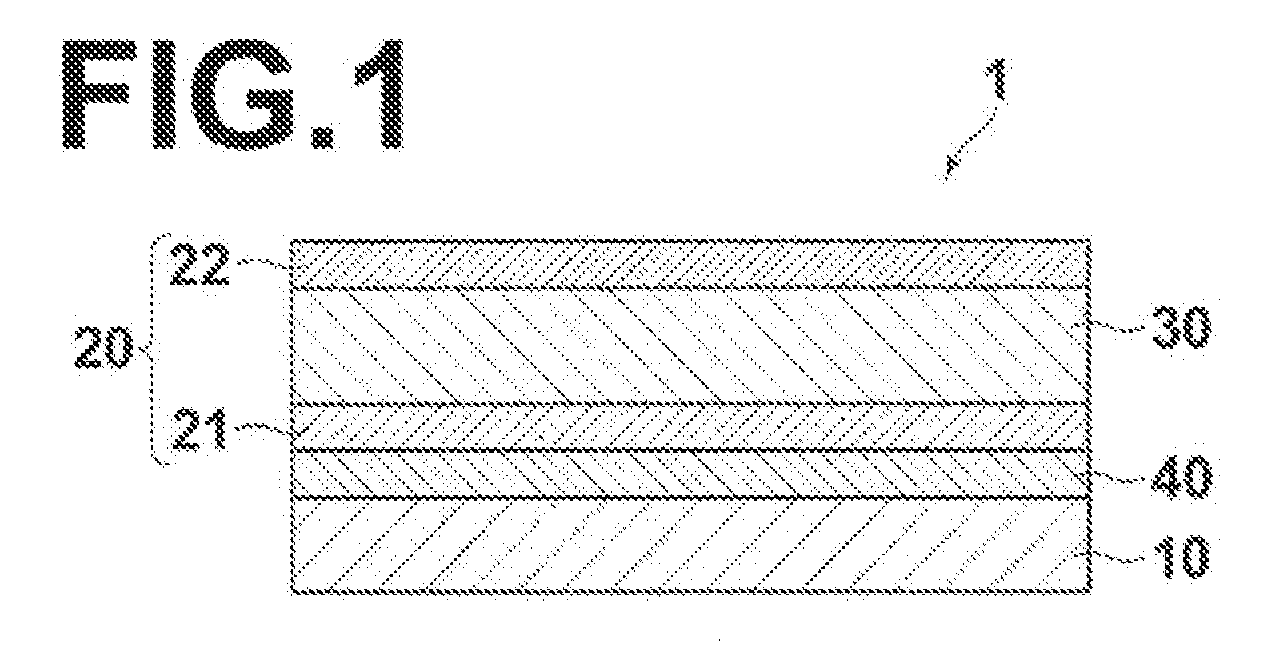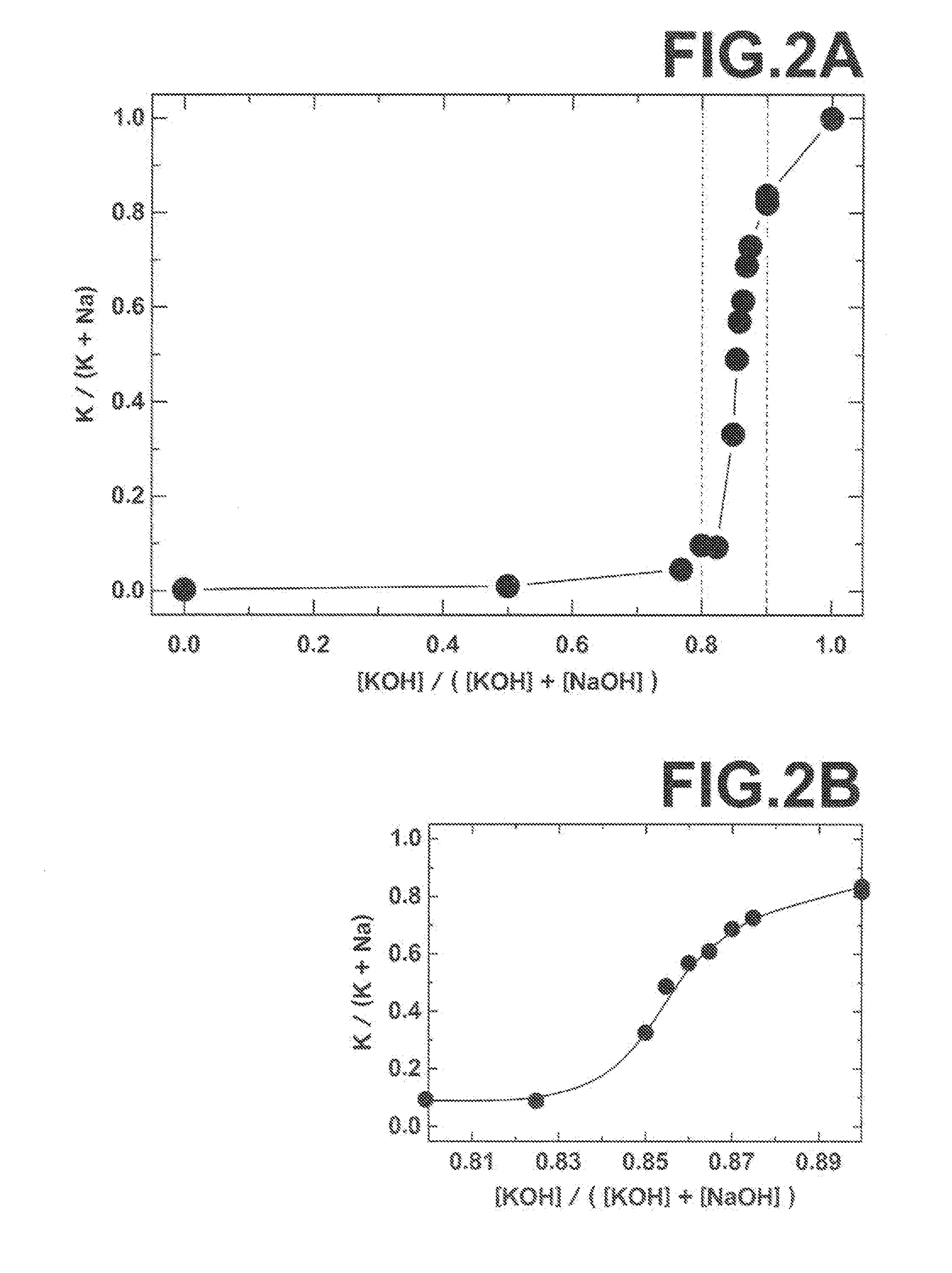Perovskite oxide film and ferroelectric film using the same, ferroelectric device, and method for manufacturing perovskite oxide film
- Summary
- Abstract
- Description
- Claims
- Application Information
AI Technical Summary
Benefits of technology
Problems solved by technology
Method used
Image
Examples
example 1
[0091]A (100) SrTiO3 (STO) substrate with a thickness of 500 μm was prepared and a SrRuO3 (SRO) back contact electrode was formed on the surface of the substrate with a thickness of about 60 nm by sputtering. In forming the electrode, a commercially available SRO target was used as the target under the following film forming conditions: output power of 60 W; substrate temperature of about 600° C.; deposition pressure of 27 Pa; argon-oxygen ratio of 20 / 5; substrate-target distance of 120 mm; and deposition time of about 220 minutes.
[0092]Then, reaction solutions were prepared. 9×10−4 mol of Nb2O5 powder, 7 mol / l of KOH, and 7 mol / l of NaOH were provided and mixed to prepare for a 20 ml of reaction solution having each of the predetermined compositions shown in Table 1.
[0093]Each reaction solution shown in Table 1 was put into a temperature controllable reaction vessel and the temperature was controlled such that the temperature of each reaction solution becomes 240° C. Then the subst...
example 2
[0099]As the substrate, following three substrates were provided.[0100]1> inconel substrate (300 μm thickness)[0101]2> SrRuO3 (SRO) / inconel substrate (300 μm thickness)
[0102]Film forming conditions: A SrRuO3 (SRO) was formed on a 300 μm thick inconel substrate by sputtering with a thickness of about 120 nm as a buffer layer. A commercially available SRO target was used as the target, Film forming conditions: output power of 40 W; substrate temperature of about 600° C.; deposition pressure of 8 Pa; argon-oxygen ratio of 70 / 30; substrate-target distance of 70 mm; and deposition time of about 60 minutes.[0103]3> SRO / La2NiO4 (LNO) / inconel substrate (300 μm thickness)
[0104]Film forming conditions: A SRO (film thickness of about 120 nm) / La2NiO4 (LNO) (film thickness of about 150) was formed on a 300 μm thick inconel substrate by sputtering as a buffer layer. A commercially available SRO and LNO targets were used as the targets. With respect to the LNO, film forming was performed under thr...
example 3
[0113]A 300 μm thick inconel substrate formed in a cantilever shape by wire electrical discharge machining was provided and SrRuO3(SRO) was formed on the surface thereof with a thickness of about 120 nm as a buffer layer. The film forming conditions were similar to those of the substrate 2 in Example 2.
[0114]Then, a 20 ml of reaction solution having the same composition as that of No. 12 in Table 1 was prepared, and a (K, Na)NbO3 film was formed on the SRO buffer layer with a thickness of about 6 μm as in each substrate in Example 2. The results of composition analysis performed in the same manner as in Example 1 showed that the composition of K / (K+Na) in the film was 0.88.
[0115]Next, an Au upper electrode was provided on the (K, Na)NbO3 film by low vacuum vapor deposition, thereby providing a measuring sample (cantilever) for piezoelectric property evaluation. Note that the sample was not subjected to polarization treatment. The piezoelectric property evaluation was performed by a ...
PUM
| Property | Measurement | Unit |
|---|---|---|
| Temperature | aaaaa | aaaaa |
| Lattice constant | aaaaa | aaaaa |
| Thickness | aaaaa | aaaaa |
Abstract
Description
Claims
Application Information
 Login to View More
Login to View More - R&D
- Intellectual Property
- Life Sciences
- Materials
- Tech Scout
- Unparalleled Data Quality
- Higher Quality Content
- 60% Fewer Hallucinations
Browse by: Latest US Patents, China's latest patents, Technical Efficacy Thesaurus, Application Domain, Technology Topic, Popular Technical Reports.
© 2025 PatSnap. All rights reserved.Legal|Privacy policy|Modern Slavery Act Transparency Statement|Sitemap|About US| Contact US: help@patsnap.com



